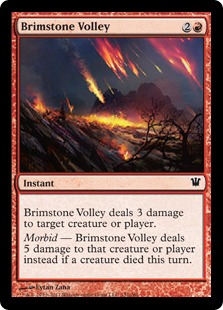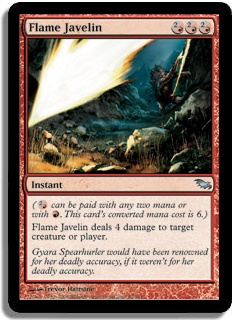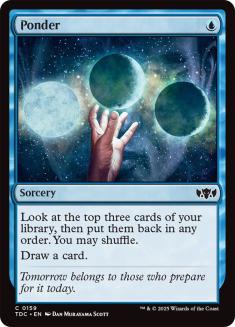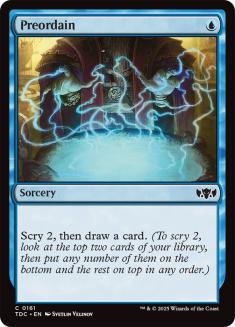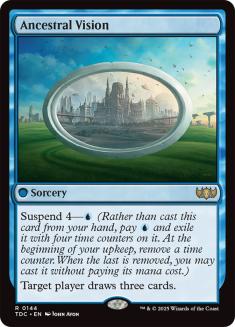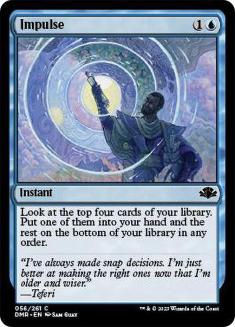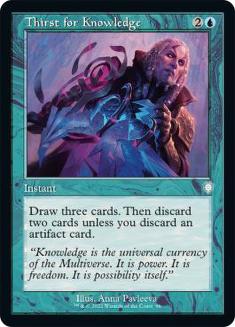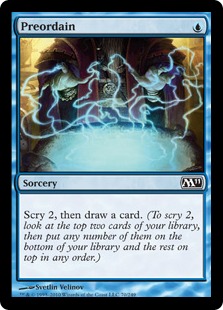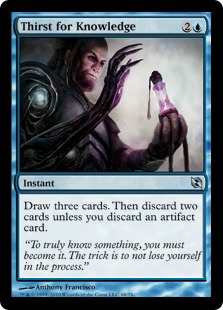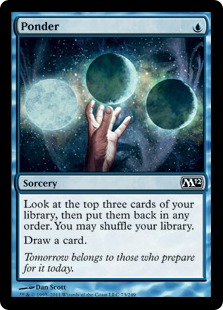In the “Gleaming the Cube” episode of The Magic Show that got me and many others into cube drafting, Evan talked about how one of the most interesting and best aspects of cube drafting is pitting cards against each other and the ensuing debates that follow. He illustrated this with a segment of him and his friends debating on whether Meloku, the Clouded Mirror was better than Vesuvan Shapeshifter.
Although I’d say Meloku in a heartbeat, the segment focuses on something that hasn’t really been discussed in many cube articles: comparing existing similar cards and how they function in cube. I’ve had many great discussions and debates about the merits of one card over another in decks and cubes. Articles comparing similar cards have been a stalwart of Magic writing since the Dojo days, with articles and blog posts comparing cards, particularly ones with limited slots like big mana finishers (is Consecrated Sphinx better than Karn Liberated or Wurmcoil Engine in Standard?). These blog posts and articles continue to be popular to this day because they’re excellent reading material, helping people make decisions on what cards to use in their decks or at least helping people critically think about the pros and cons of the cards themselves. In this article, I’ll be doing something similar, pitting several cards against each other and asking several StarCityGames.com writers how they rank those cards amongst one another for Cube.
On my Twitter account, I frequently ask questions pitting cards against one another—cards that either share a similar function or casting cost: “Izzet Boilerworks vs. Cascade Bluffs? Into the Roil vs. Repeal? Brimstone Volley vs. Flame Javelin?” I’ve asked these questions not only for getting advice on what cards to use in my cube, but to give people a general thought exercise by having people critically think about the power of each of those cards, since many people never really think of pitting those types of cards against each other; they just consider the compared cards to be generally good. Â
With Flame Javelin and Brimstone Volley, saying “direct damage is amazing, just use both Brimstone Volley and Flame Javelin!” may be a retort to the question, but not necessarily a correct one. I’ve talked about how, due to a cube’s finite size, there’s only room for so many cards and cards that may be considered sacred may end up in the on-deck binder because of the limited space. While some cubes may be able to presently use both Flame Javelin and Brimstone Volley, eventually there will come a point where only one can be used, either in a cube itself or when you can only use one in the deck (and when that happens, you’ll be glad you thought about that comparison!).
You may be expecting me to compare the “heavy hitters” of cube, asking whether Library of Alexandria is better than Black Lotus, whether Umezawa’s Jitte is better than Skullclamp, or whether Time Walk is better than Tinker. I may do that in another article in a similar fashion to when Evan Erwin asked people what the top 5 cube cards were in his article “The Cube 2.0” from 2006. Instead, I’ll be making some less exciting comparisons, comparing several innocuous, yet important cube cards.
All of these cards are relatively safe cards, cards that won’t be in many sideboards, but also aren’t the stuff of cube lore—or at least, these aren’t the cards that many people actively look for when cube drafting (although I like to have at least one of these in my blue decks). Instead, all of these cards generally smooth decks out and make them more consistent. Think of Jace, the Mind Sculptor, how Preordain was its BFF in many decks when they were both in Standard, and how Preordain was considered a vitally important spell to the decks even though Preordain was a much less exciting card than Jace; good ol’ Preordain was a truly safe card.
Because of this, many people generally don’t spend much time thinking about these types of safe cards for their cube, and since they’re almost always going to make a deck, they’re considered sacrosanct for their cubes. But much like the Brimstone Volley example, there may be a time when you won’t be able to use all five of those cards in your cube, or you may have to choose between keeping one of those safe spells in the sideboard/ship it in a cube draft.
I had never really thought about the ranking of those cards, and with Thirst for Knowledge, its value definitely changes if you’re in a strategy like reanimator or a deck with a lot of artifacts (aka ‘the Tezzeret deck’), but for the most part, I had always considered these cards to have a similar role and power level in a cube, with a slight nod towards Preordain, as it smoothes out draws like few other spells can at an extremely cheap cost. Each particular spell has its respective talking points:
- Ponder lets you dig four cards deep if need be, but it can be worse than Preordain if you want to keep only one of those cards. Sorcery speed can also be awkward for blue control decks if cast on turn 2, when you’d rather be holding control mana up or casting a mana rock like a Signet. Both spells don’t offer card advantage but offer card selection, which is useful in a format with lots of strong silver bullets.
- Ancestral Vision has the highest potential upside by acting like Ancestral Recall, but it can resolve when the drawn cards are irrelevant, or the game can end before Ancestral Vision resolves. Sorcery speed caveat with Ponder/Preordain also applies to Ancestral Vision.
- Thirst for Knowledge is the priciest but can be used at instant speed. It can be extremely powerful if drafted with a lot of artifact/reanimation support, else its power level suffers, yet it still can be utilized by many cube decks.
- Impulse lets you dig at instant speed, unlike Ponder, Preordain, and Ancestral Vision, but comes at a higher price than those spells. Unlike Ancestral Vision and Thirst for Knowledge, it doesn’t offer card advantage but card selection, which may be worse at two mana than at one with Ponder and Preordain.
As discussed earlier with regards to asking comparative questions about cards, I think that it’s a good idea to burn some mental calories on ranking these cards. To do so, I’ve asked fellow StarCityGames.com writers Reuben Bresler, Sam Black, Justin Parnell, A.J. Kerrigan, Gerry Thompson, Thea Steele, Adam Prosak, Patrick Sullivan, Ali Aintrazi, Larry Swasey, and Todd Anderson for their opinions on how these cards compare against each other in a best to worst ranking (1st getting 5 points, 2nd getting 4 points, and so on). This is the result:
1st with 51 points
2nd (tie) with 38 points
4th with 25 points
5th with 13 points
When I tallied up all of the votes, despite having general patterns towards voting for some cards over others (the general trend of voting for Ancestral Vision high and Impulse and Ponder low), no one had the same ranking for the five cards. I was quite surprised with the high ranking of Ancestral Vision; my personal cube experience with it has been shorter than my experiences with the other four cards, but I’ve been trying it in my cube with success and have found that games don’t end with it suspended as much as I had initially feared.
Obviously one can’t rely on getting it early as much as someone could when they could use four copies, like during Time Spiral-Lorwyn Standard. Faeries had four copies of Ancestral Vision, but I have still found it to be consistent. Regardless, I was surprised that the difference between Ponder/Thirst and Ancestral Vision was so high but not too surprised that Preordain was the 2nd highest (or at least, tied for it), as the ability to dig for a certain card while jettisoning other less useful cards is extremely useful, and Preordain performs that task very well, but in that same vein, I’m surprised that Impulse fared lower than Thirst for Knowledge in the vote.
I’m going to highlight Adam Prosak response, since if anyone knows how to utilize one-blue-mana library manipulation spells in just about any deck, it’s him!
“I would order them Vision, Impulse, Preordain, Thirst, Ponder. Vision obviously has the highest upside, but you can’t guarantee that you can afford to wait on any card drawing spell. It’s also the worst at finding lands early. Still, Vision breaks games like no other card on the list. The rest assume you have some other card you really need that you’re willing to pay extra for. Thirst is the best in some decks (artifact decks or decks with Genesis, etc.) but Dream Cache in some others. I prefer Impulse to Preordain simply because it is just as easy to find 2 mana at instant speed lying around as it is 1 mana at sorcery speed. Both are very easy. Ponder is an Impulse if you can shuffle.”
Fellow cube writer Justin Parnell had a slightly different take on the ranking:
“Visions, Thirst, Impulse, Preordain, Ponder. Raw power of Visions that fits in blue decks that can cast it by t3, Instant speed card selection of Thirst and Impulse—with added bonus of graveyard/artifact shenanigans that accompany Thirst. The last two I don’t really care for at all; neither is impactful enough for most decks at sorcery speed. If we’re talking a cube with multiple combos, they get better, but that would just move Thirst and Visions down rather than them up.”
I’m by no means implying that these point tallies are a be all, end all of evaluation and that if you’re using Ponder and Impulse instead of Thirst for Knowledge and Preordain that you’re doing it wrong; instead, the purpose of this article is for you to think about the role that those cards play in your cube and when you’re drafting them in someone else’s cube and that even if your ranking is completely different from the composite tally or Adam’s and Justin’s rankings, it’s a good idea to think about how these cards compare.
Even if you have a cube and have no intention of ever taking out one of these cards, let’s say that you’re drafting someone’s cube and that person thinks that Ancestral Vision is a bad card, how does your pick order change? If you’re an Ancestral Vision fan who sees that it’s not in the drafted cube, but instead see Ponder and Impulse, do you then start to value the other library manipulation spells higher in that draft? How would your draft strategy change? How would YOU rank those 5 cards? Post your rankings in the comments!
I hope that this article has given you some new insight on some cards whose place you may have taken for granted in cube—it’s very important for cubing to critically evaluate the value of each of the cards and critically evaluate them against cards of similar function and cost.
May all of your opening packs contain Sol Rings!
@UsmanTheRad on Twitter
My blog, I’d Rather Be Cubing, featuring my powered & pauper cube lists:Â http://idratherbecubing.wordpress.com
Cube podcast that Anthony Avitollo and I co-host: The Third Power

